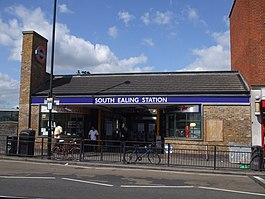South Ealing tube station
| South Ealing | |
|---|---|
 | |
 South Ealing Location of South Ealing in Greater London | |
| Location | Ealing |
| Local authority | London Borough of Ealing |
| Managed by | London Underground |
| Number of platforms | 4 |
| Fare zone | 3 |
| London Underground annual entry and exit | |
| 2016 | |
| 2017 | |
| 2018 | |
| 2019 | |
| 2020 | |
| Railway companies | |
| Original company | District Railway |
| Key dates | |
| 1 May 1883 | Station opened |
| 29 April 1935 | Piccadilly line service introduced |
| 1964 | District line service withdrawn |
| Other information | |
| External links | |
| WGS84 | 51°30′04″N 0°18′26″W / 51.50111°N 0.30722°WCoordinates: 51°30′04″N 0°18′26″W / 51.50111°N 0.30722°W |
South Ealing tube station is a London Underground station in the London Borough of Ealing. The station is on the Heathrow Airport branch of the Piccadilly line, between Acton Town and Northfields stations.[5] It is located on South Ealing Road and is in Travelcard Zone 3.[5]
Station information[]
South Ealing tube station has a waiting room.[6]
The station does not offer step-free access from the train or platform to street level.[5]
Like all other London Underground stations, South Ealing has a Labyrinth artwork by Mark Wallinger, in place since 2013.[7]
Connections[]
London Buses route 65 and night route N65 serve the station.[8]
History[]
South Ealing station was opened as a stop on the District Railway (later the District line) on 1 May 1883. These trains were initially steam-powered, but the line has been electrified since 1905.
The station has been served by the Piccadilly line since 29 April 1935. It was modernised between 1935 and 1936, with the original buildings replaced, the eastbound platform receiving a new concrete canopy and waiting room and electric lights being installed.[9]
The District line service was withdrawn in 1964.[9]
The station building was again replaced in 1983.[9] It was refurbished once more in 2006.[7]
Gallery[]

Piccadilly Line train approaching South Ealing

Piccadilly Line train leaving South Ealing, headed westwards.

1973 Stock passing.

Eastbound platform building.

Waiting enclosure of glass & metal.
References[]
- ^ a b "Multi-year station entry-and-exit figures (2007–2017)". London Underground station passenger usage data. Transport for London. January 2018. Archived from the original (XLSX) on 31 July 2018. Retrieved 22 July 2018.
- ^ "Station Usage Data" (CSV). Usage Statistics for London Stations, 2018. Transport for London. 21 August 2019. Archived from the original on 22 May 2020. Retrieved 27 April 2020.
- ^ "Station Usage Data" (XLSX). Usage Statistics for London Stations, 2019. Transport for London. 23 September 2020. Archived from the original on 9 November 2020. Retrieved 9 November 2020.
- ^ "Station Usage Data" (XLSX). Usage Statistics for London Stations, 2020. Transport for London. 16 April 2021. Retrieved 1 January 2022.
- ^ a b c Standard Tube Map (PDF) (Map). Not to scale. Transport for London. October 2021. Archived (PDF) from the original on 14 November 2021. Retrieved 14 November 2021.
- ^ "South Ealing Underground Station". Transport for London. Retrieved 28 March 2020.
- ^ a b "Labyrinth 260/270 – South Ealing". art.tfl.gov.uk. 14 May 2013. Retrieved 28 March 2020.
- ^ "Buses from South Ealing" (PDF). TfL. April 2020. Retrieved 22 August 2021.
- ^ a b c Wallinger, Mark (2014). Labyrinth – A Journey Through London's Underground. Art / Books. p. 287. ISBN 978-1-908970-16-9.
External links[]
| Wikimedia Commons has media related to South Ealing tube station. |
- "South Ealing". Photographic Archive. London Transport Museum. Archived from the original on 10 February 2014.
- Rail transport stations in London fare zone 3
- Piccadilly line stations
- London Underground Night Tube stations
- Tube stations in the London Borough of Ealing
- Former Metropolitan District Railway stations
- Railway stations in Great Britain opened in 1883





